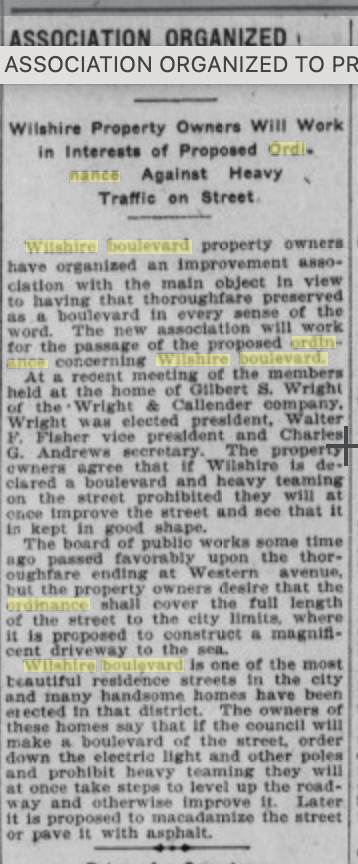Northern California's gold fields attracted prospectors from around the world, including France. Some unsuccessful Frenchmen left for Los Angeles, which still boasted an ample supply of cheap land and already had a growing French community that could help them raise money to return home - or to find work, buy land, and settle permanently.
Joseph Masselin was one of them. Hailing from Haute-Normandie, Masselin was seventeen when gold was found halfway around the world at Sutter's Mill.
Sources disagree on whether the Masselin family stayed in Northern California until 1859 or until 1870, which was more than 20 years after the gold rush began. Masselin was married to Aquitaine native Marie Sehabiague, and they had six children: John Baptiste, Jennie, Joseph, Zellie, Julia, and Cornelia.
In 1870, Los Angeles was expanding east (really). Unable to afford ranch lands on the Eastside, Masselin bought 120 acres of much-cheaper farmland on what was then the Westside.
Specifically, the farm fronted what is now Wilshire Boulevard.
A family member's obituary states that the farm was bounded by Wilshire, Rimpau, Olympic, and "what is now La Brea". I checked this claim against an acreage calculator and found it to be about 148 acres, not 120. Since there are multiple references to the farm fronting Wilshire, I'm certain of that boundary, but I can't be 100 percent sure that the others are accurate. Masselin bought land throughout his life, so it's certainly possible he expanded the farm at a later date.
Masselin also began buying land on the old Rancho La Cienega and in the Beaudry Tract within a decade of his arrival. He was later known as a major landowner in the Cahuenga Valley (southeastern Hollywood).
Like so many Frenchmen before and after him, Masselin raised sheep, partnering with Rock Sarrail on the Verdugo ranch. Although other Frenchmen were ruined when the price of wool suddenly dropped, Masselin and Sarrail survived the crash, and did well enough to expand to Bolsa Grande (Garden Grove), Bolsa Chica (Huntington Beach), and San Diego County.
Masselin also became a city councilman, often served on the Bastille Day committee, and championed civic improvements as an early planning commissioner.
Masselin partnered with T.J. Molle in a store, selling coal, hay, wood, grain, and such on Eighth Street between Main and Spring. Molle left in 1891, leaving Masselin to fill orders alone.
Masselin passed away in 1898 at age 68, and is interred in Calvary Cemetery with his wife and their children (in eight adjoining mausoleum vaults). But this story doesn't end with him.
Much of what we now call Wilshire Boulevard was initially a path used by the Tongva people, and for nearly all of Masselin's lifetime it was known as Calle de los Indios. Wilshire Boulevard as we know it today was born closer to downtown, in 1895, and slowly expanded both east and west.
Henry Gaylord Wilshire initially planned for Wilshire Boulevard to be 15 blocks long and 60 feet wide, with 35-foot sidewalks, and to be paired with a hotel. He soon applied to build an electric railroad that would run through Westlake and on the proposed Boulevard.
The "Wilshire Boulevard Ordinance", proposed in 1899 and later upheld by the city, sought to protect the stylish new thoroughfare from "heavy teaming, particularly the hauling of oil." (This is somewhat ironic, given that Wilshire Boulevard's predecessor Calle de los Indios was used by the Tongva to collect tar from the La Brea Tar Pits and haul it to the coast, where they would use it to fill the cracks in their wooden plank canoes.) Oil vendors took the matter to court a year later and won.
Wilshire Boulevard was intended for "boulevard and park purposes" rather than business purposes, although it's certainly much busier now than Wilshire and the interested property owners could ever have imagined. The issue of banning heavy vehicles from the Boulevard came up over and over, and the ordinance was deemed valid again and again.
 |
| 1908 news blurb on "boulevardizing" Wilshire Boulevard |
 |
| 1909 blurb on a court hearing for the Wilshire Boulevard ordinance. Joseph Masselin (II) was present at the final hearing. |
The farm's end came in 1922, when the Masselin family sold their last 73 acres to the developers of the Wilshire Vista tract.
 |
| 1922 clipping on the sale of the Masselin farm's last 73 acres to the Wilshire Vista tract |
The Masselin farm may be long gone, but Masselin Avenue still bears their name, just eight short blocks from the farm's western boundary. Masselin Avenue runs north-south, intersecting with Wilshire Boulevard.
No comments:
Post a Comment